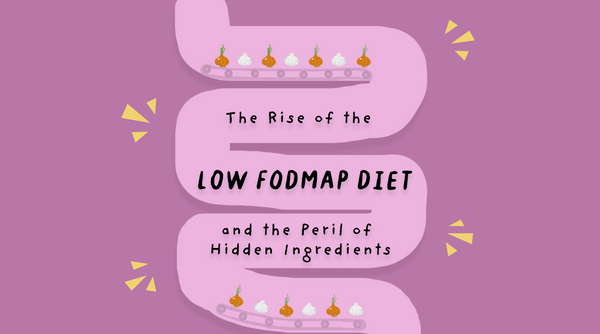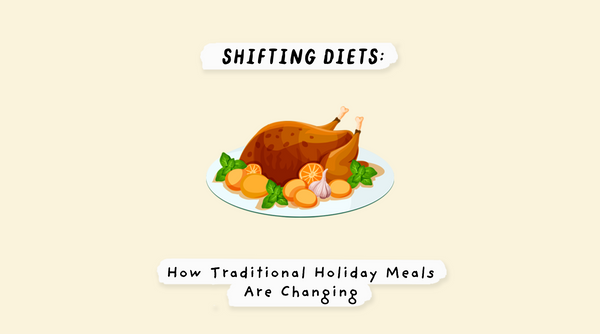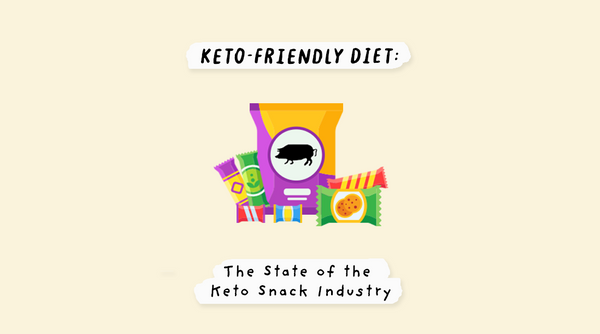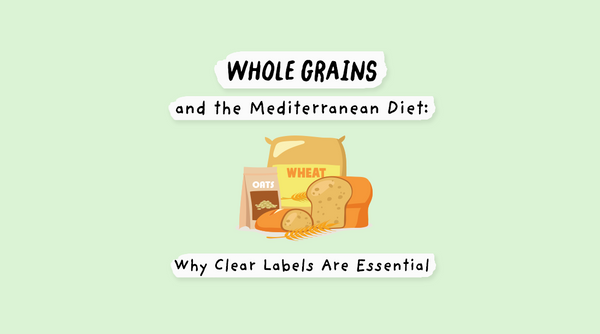A brief look
- Irritable bowel syndrome (IBS) affects 10-15% of the world’s population, and while it has no known cure, people are increasingly turning to an elimination diet called low FODMAP to manage their symptoms.
- Studies show that up to 86% of IBS patients that have tried low FODMAP have seen improvement in their symptoms.
- In the US, interest in the search term ‘FODMAP’ has risen 127% over the last 5 years.
- Despite the growing number of people following the diet, low FODMAP options can be scarce in some categories of packaged products, and consumers often struggle to find options that fit their needs.
- Onion and garlic were found to be the most common FODMAPs across five different categories of products.
- FODMAPs often hide under umbrella terms such as natural flavors, which can hinder people’s ability to determine if a product is safe to consume. Brands with more transparent ingredient labeling stand to gain trust and loyalty from consumers looking to adhere to a low FODMAP diet.
Dive deeper
People with irritable bowel syndrome (IBS) tend to experience frequent bloating, diarrhea, constipation, and abdominal cramping due to their sensitive guts. IBS is a common gastrointestinal disorder that affects about 10-15% of the world’s population. For years, doctors recommended managing dietary fiber intake or following a broad-based elimination diet to alleviate IBS symptoms, but recently, the low FODMAP diet has gained popularity among both dietitians and IBS patients. Since studies have shown that up to 86% of IBS patients see an improvement in their symptoms after following the diet, it’s no surprise that interest in the diet has grown.
The acronym FODMAP stands for Fermentable Oligosaccharides, Disaccharides, Monosaccharides, and Polyols. Despite their long names, these are actually just short-chain carbohydrates, essentially fermentable sugars that are present in our food. Some common examples of fermentable sugars are:
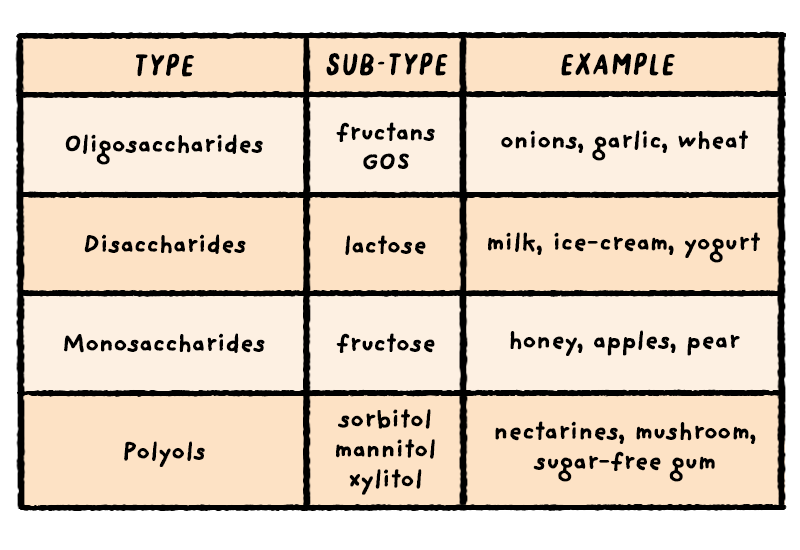
Researchers who developed the diet at Monash University explain that these sugars cannot be properly absorbed in the small intestine and are fermented by bacteria in the large intestine instead. This process produces gas, resulting in bloating and abdominal pain/discomfort for those with a sensitive gut. Moreover, due to the osmotic nature of the FODMAPs, they draw water into the bowel as they move along the intestine tract, which could then cause diarrhea.
The low FODMAP diet aims to ease these symptoms by helping those with IBS pinpoint which groups within the FODMAPs are responsible for the reaction in their gut. To do this, the diet has a three-step plan that includes eliminating the FODMAPs, reintroducing them, and recording reactions to them.
FODMAPs may cause diarrhea and bloating in those with IBS
This is fairly easy if you can choose the ingredients yourself and do all your own cooking. However, the truth is most people just don’t have time for that. Even if you make, say, a salad, from scratch, you may still encounter problems if you top it with a store-bought salad dressing.
We looked at the majority of packaged products available in major US grocery stores via the Pinto database and we found that there were categories in which the percentage of low FODMAP options available was below 10% and, in some cases, 0%.
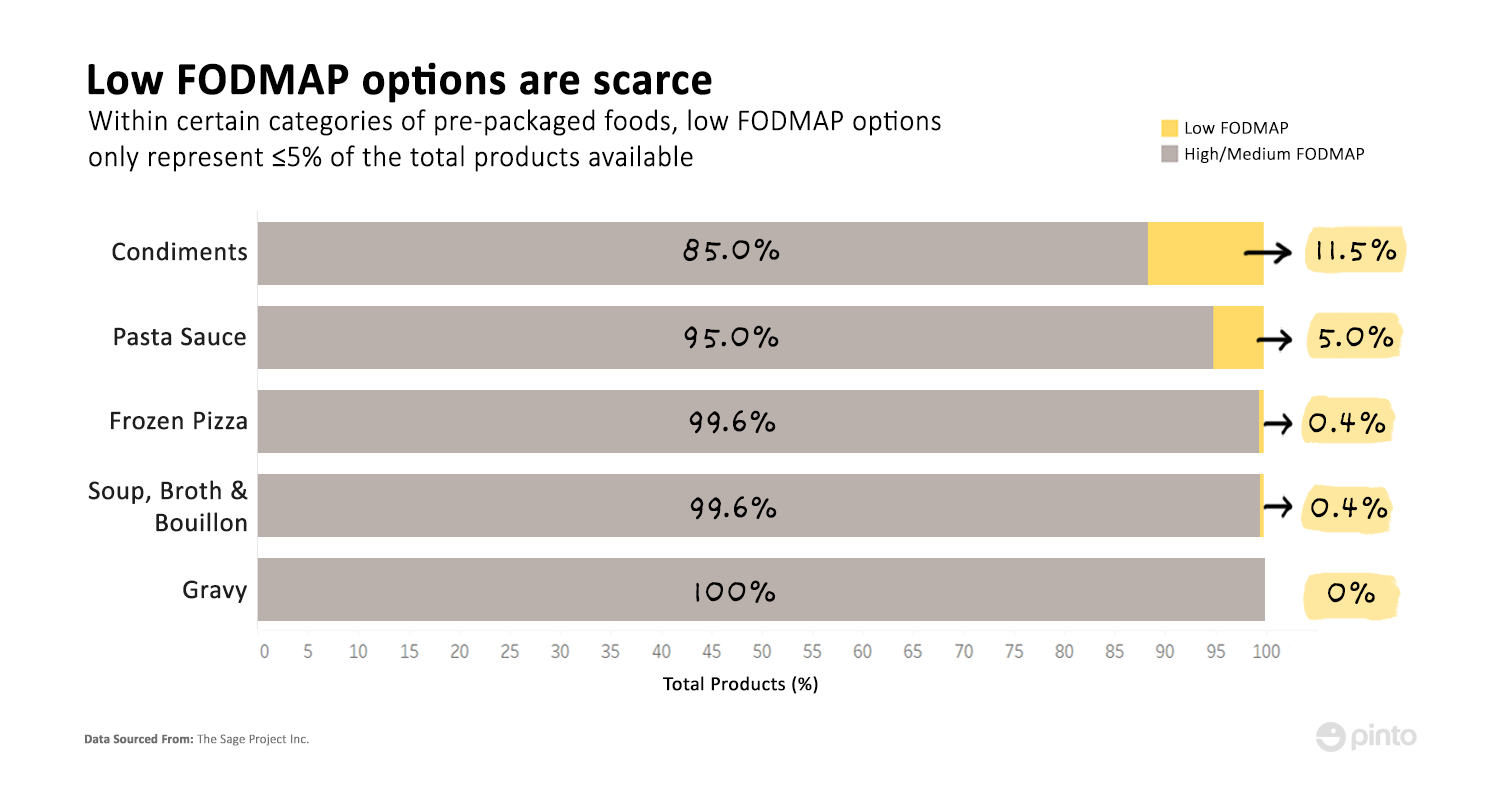
As evident from the graph above, in terms of common convenience food categories, finding low FODMAP foods is quite challenging. When it comes to condiments, things may be complicated given the diversity within the category, but at least there are a few options.
In recent years, consumer interest in the condiment category has been on the rise. Since 2016, revenue growth for the condiment sector in the US has been increasing steadily from around $40.5 million to $42.7 million in 2019 and it is expected to grow even more in the following years. This could be due to the fact that most companies have been listening to their customers. Responding to consumer demand, condiment manufacturers have introduced versions of their products that are low in sodium or have no added sugars. However, when it comes to low FODMAP options, there is still some work to do.
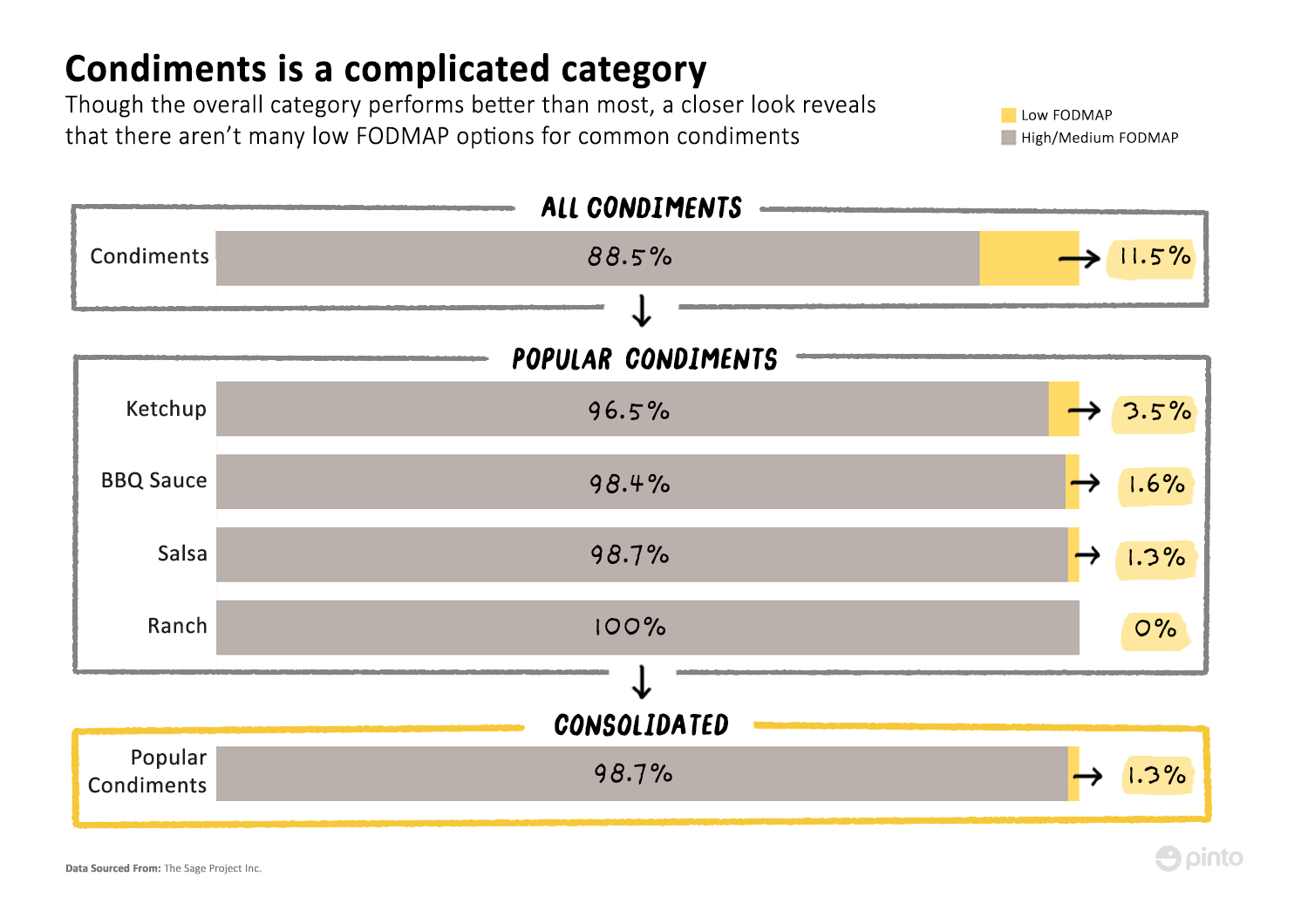
We took a look at some of the most popular condiments—ketchup, barbecue sauce, ranch dressing, and salsa—and found that within each category, less than 4% of the products were low FODMAP. This is significantly lower than the overall 11.2% reported for the condiments category. Moreover, specifically in the case of ranch dressing, there were no low FODMAP options at all. This is surprising considering that ranch has gained massive popularity, ranking in first place as the most beloved dressing in America in 2017 in a survey by the Association for Dressings and Sauces, as well as taking the crown as most popular condiment across six states in America in a survey by Influenster in early 2019.
Many people following the low FODMAP diet are still unable to find low FODMAP options for some of their favorite condiments. By grouping the four condiments together, and looking at the group in tandem with other categories, we were able to find a common factor between the categories, eventually revealing why low FODMAP options are so scarce between them.
So, what exactly is that factor? Well, the answer lies buried in the ingredient label. For some of those following the low FODMAP diet, it should come as no surprise as these ingredients are the bane of their existence, for all it takes is just a pinch to cause their symptoms to flare up.
That’s right, we’re talking about onions and garlic.
Onions and garlic are the most common FODMAPs in savory products
A quick search through our database revealed that within the eight categories we examined, of those products containing FODMAPs, onions and garlic appeared in 79-100% of them, making it the most common FODMAP across all the categories below.
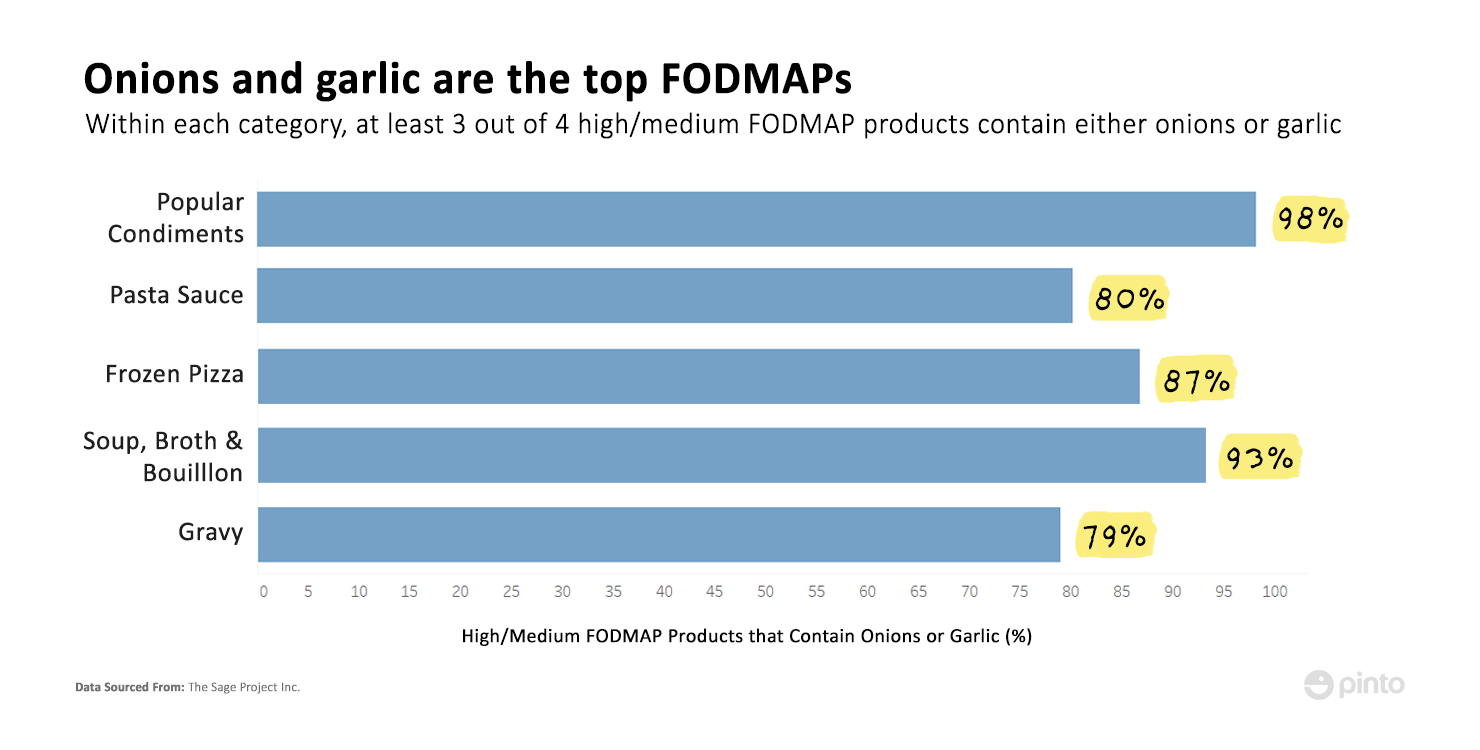
For those on the low FODMAP diet, onions and garlic tend to be the top ingredients to avoid because of their fructan content. Fructans are oligosaccharides and are found in abundance in onions and garlic. Even when the vegetables are consumed in small amounts, the high fructan content can cause adverse reactions in the gut. Complicating matters for IBS sufferers, onions and garlic appear in foods from around the world and are a staple in just about every kitchen.
When onions and garlic are listed on the ingredient label, they’re easy enough to avoid, but sometimes they still find their way into your favorite foods.
Can products with no onions or garlic listed still be a problem?
Generally, if a product contains a specific ingredient, it has to be listed on the label. Sure, manufacturers have on occasion come up with creative names for certain ingredients, but the fact remains that they are still on the ingredients list. However, for some ingredients, vague terminology allows them to hide in plain sight.
If you look at the ingredient label of a number of products on the shelf, you are bound to find an ingredient called natural flavors on the package. It might not say natural flavors per se; it could be labeled simply as flavors, perhaps even organic natural flavoring. Either way, they are simply different naming conventions for an umbrella term under which manufacturers can lump together anything that has been derived naturally.
This usually isn’t done for nefarious purposes. It’s often just a way to simplify the label and keep the list to a manageable size. For example, a packet of assorted gummy bears might have five flavors: cherry, lime, lemon, grape, and orange. Instead of listing them one by one as cherry extract, and so on, they can all simply be lumped under one ingredient and that’s flavors. It’s a convenient term, one that manufacturers have grown to love now that consumers tend to look for products with shorter ingredient lists, but it is problematic for people trying to stick to a low FODMAP diet.
The finer points of reading a product label – powders vs. extracts
Following a low FODMAP diet means that you have to become good at reading product labels. It means being able to find the dastardly FODMAPs that adversely affect you. However, it’s difficult to avoid an ingredient that is not on the label yet still present in the product. That’s why onions and garlic pose such a big problem for those on the low FODMAP diet. The fact that it can be included under natural flavors means that one can never be too sure if the product is truly free of onions and garlic.
Though the FDA mandates that granulated or powdered forms of onions or garlic must be listed under their common name—such as powdered onions—and not be labeled as a flavor compound, onions and garlic can still be listed as natural flavors if oils, oleoresins, or natural extractives of the vegetables are used instead of the powdered version. A common example of this would be onion or garlic extract.
Onions and garlic can still be listed as natural flavors if oils, oleoresins, or natural extractives of the vegetables are used instead of the powdered version.
That’s why most following the low FODMAP diet operate under the assumption that if the product they are purchasing is a savory one and the ingredient natural flavors is present, then it is wise to assume that it contains onions or garlic. Of course, this tip can be ignored if buying something like gummy bears. It would be highly unlikely for manufacturers to include onion or garlic flavors in gummy bears. However, in the case of savory products, you should proceed cautiously when you spot natural flavors on the ingredient list.
Although it surely could be a likely scenario that you would find a product with no onions or garlic on the ingredient list, instead a curious little ‘natural flavors’ towards the end, one might wonder how often does this actually occur? Is it truly even a problem? To answer that, we’ll let the numbers speak for themselves.
By looking at all the products that did not have onion or garlic explicitly mentioned on their ingredient list, we found that more than 20% of products in categories such as popular condiments, frozen pizza, and soup, broth and bouillon, had natural flavors on their ingredient list. For gravy, this number rose to 81%.
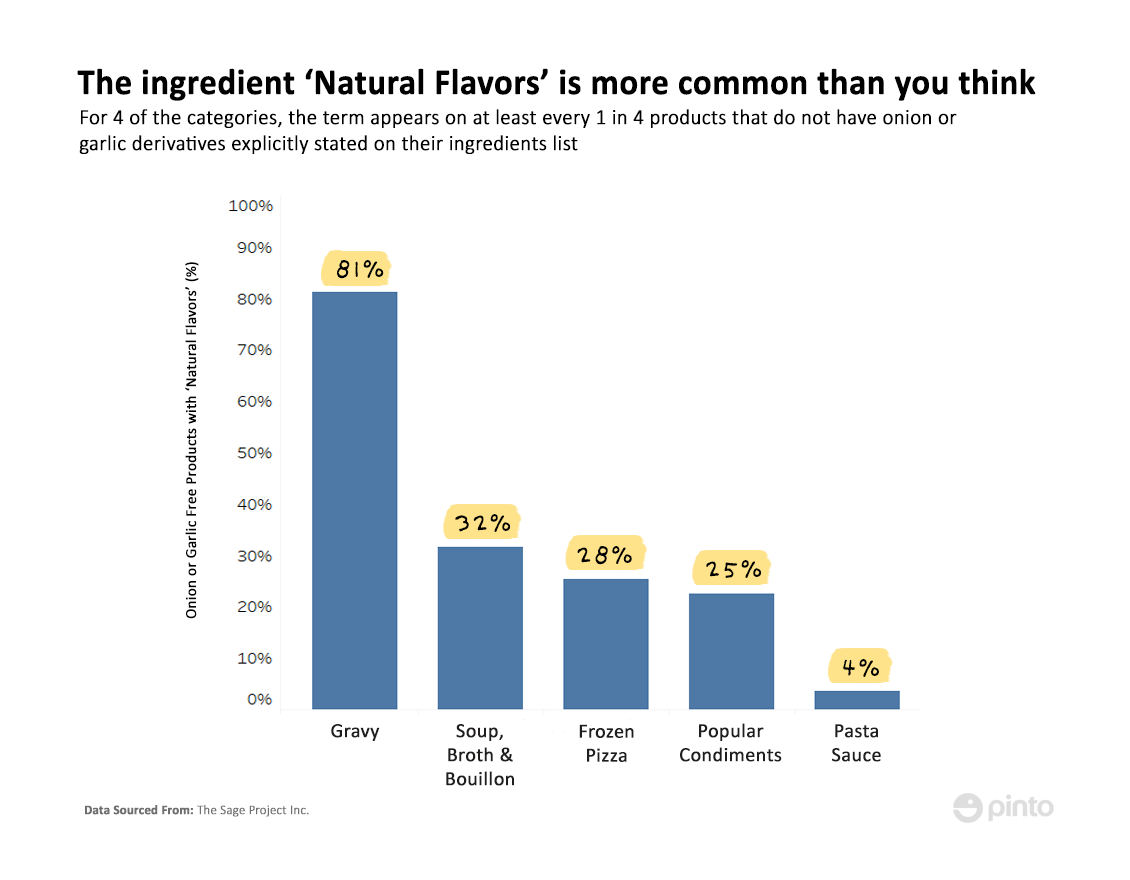
Those numbers aside, some might argue that onions and garlic being included under natural flavors isn’t actually a problem for those following a low FODMAP diet. After all, they are considered FODMAPs due to their fructan content and since fructans (the fermentable sugar present in onions and garlic) are water soluble and not oil-soluble, oil-based extracts should not affect those with IBS. That’s why seasonings like garlic infused oil can be used by low FODMAP followers to impart garlic flavor to their food with no consequences. Unfortunately, in the case of commercially used extracts, residual fructans may still find their way into the extract during processing. There really is no way of knowing if the fructan content in the extract is negligible unless it’s tested in a lab. After all, half a garlic clove, which is about 1 gram of garlic, is already considered a high FODMAP food, so it wouldn’t take much to render a product non-FODMAP friendly.
To make matters more complicated, so far, we’ve only discussed FDA-regulated food. What about USDA-regulated food?
USDA and FDA define the term natural flavors differently
Though most packaged food falls under FDA’s jurisdiction, there is a subset that the USDA oversees instead. Typically, these are foods containing greater than 2% cooked meat such as some pasta sauces or frozen pizzas. These products have different rules when it comes to the term natural flavors because, unlike the FDA, the USDA allows powdered or granulated versions of onion and garlic to be included under the umbrella term. So, just be aware that if you see natural flavors on the ingredient label of a product like frozen pizza, the product could potentially contain onions and garlic.
Yes, all of this can be confusing, but to make things easier for those following the low FODMAP diet, some companies have moved to designate their products as low FODMAP by acquiring a certification from Monash University, where the diet was founded. All products with the Monash University low FODMAP badge have been lab tested to ensure that one serving of the product is low FODMAP. This can mean that even if the product, in general, contains a high FODMAP ingredient, if you only have one serving, it will still be considered low FODMAP due to the negligible amount of FODMAPs per serving.

Although it definitely helps to have low FODMAP certified products, the truth is that some people following the low FODMAP diet have figured out what exactly irritates their gut and can consume some FODMAPs. For example, let’s say a man with IBS named Steve follows the low FODMAP diet. For him, even a pinch of garlic powder will make him feel bloated and cause him to make frequent visits to the toilet after a meal. On the other hand, he could guzzle a gallon of milk and feel fine. So, imagine Steve is in the supermarket, looking for a creamy tomato soup he could have with his dinner tonight. He finds a can of the soup and notes that the product has so much milk in it that it couldn’t technically be considered a low FODMAP food by Monash. That’s alright, he thinks. Milk has no effect on him anyway, so he could still purchase and consume this product. Steve scans the ingredient label briefly and, to his surprise, does not see any onion or garlic, which is a good sign. However, as he continues down the list, he finds natural flavors, which means the product might have onion or garlic derivatives hiding under the umbrella term. The product could very well not have any onion or garlic derivatives in it, but there is no way for Steve to know that unless he contacts the company directly, which would probably be very time-consuming.
Companies should clarify labels now to attract low FODMAP dieters
As the low FODMAP diet continues to be recommended by dietitians to IBS patients across the world, there is a growing demand for companies to catch up to their needs. Umbrella terms like natural flavors, though not exactly harmful, prevent consumers from knowing with full confidence that their product is onion- and garlic-free. It limits the consumer’s choices, and companies stand to lose potential sales just because their ingredient lab is unclear.
To cater to this new market, companies can choose to get their products low FODMAP certified by Monash or explicitly state on their packaging that their products do not contain onion or garlic derivatives. Surely, capturing this fast-growing consumer group in the early stages will only benefit food companies in the years to come as the adoption rate for the low FODMAP diet continues to rise.


